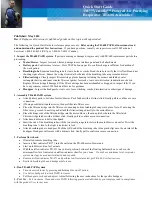
USAGE CAUTIONS
• Ventilate the room periodically during use, especially if using gas appliances.
• Be sure to turn the unit off and disconnect the power supply cord before performing any
maintenance or cleaning.
• Do not splash or pour water directly onto the unit.
Water can cause electrical shock or equipment damage.
• Drainage should be performed whenever moving the air conditioner. (See Page 17)
If any water remains in the tank, it may spill out while being moved.
• To ensure proper drainage, the drainage hose must have no kinks or be on a different level
during dehumidification mode.
The drained water may spill out into the room.
• The temperature around the drainage hose must not be below freezing point when used.
Drained water may freeze inside the hose, causing water inside the unit to overflow into the room.
• Do not block the exhaust air outlet with obstacles.
Cooling performance may be reduced or stop completely.
• Provide an earth leakage breaker in order to protect against electric shock in case of leak.
Use
the current-activated, high-sensitivity, high-speed type breaker with a rated sensitivity current of be-
low 30 mA and an operating time of below 0.1 second.
NOTES ON OPERATION
• Allow 3 minutes for the compressor to restart cooling.
If you turn the air conditioner off and immediately restart it, allow three minutes for the compressor to
restart cooling. There is an electronic device in the unit that keeps the compressor turned off for three
minutes for safety.
• In the event of a power failure during use, allow 3 minutes before restarting the unit.
After power is reinstated, restart the air conditioner. If the power was off for less than three minutes,
be sure to wait at least three minutes before restarting the unit. If you restart the air conditioner within
three minutes, a protective device in the unit may cause the compressor to shut off. This protective
device will prevent cooling for about 5 minutes. Any previous settings will be canceled and the unit
will return to its initial settings.
• Low temperature operation: Is your unit freezing up?
Freezing may occur when the unit is set close to 18°C in low ambient temperature conditions,
especially at night.
In these conditions, a further temperature drop may cause the unit to freeze.
Setting the unit to a higher temperature will prevent it from freezing.
• Dehumidification mode increases room temperature.
The unit generates heat during dehumidification mode and the room temperature will rise. Warm air
will be blown out from the Exhaust air outlet, but this is normal and does not indicate a problem with
the unit.
• This air conditioner blows the warm air generated by the unit outside the room via the ex-
haust hose while in cool mode.
Accordingly, the same amount of air as that blown out will enter the room from outside through any
openings into the room.
OPERATING CONDITIONS
• The air conditioner must be operated within the temperature range indicated below.
IMPORTANT SAFETY INSTRUCTIONS
E-2
* Available for operation at condition of supply
voltage 220 V or over, not exceeding 240 V.
• A built-in safety device may cut off operation if
the temperature exceeds these limits.
• When cooling operation is performed at high
room temperature, the fan may run slightly
slowed
Mode
Room temperature
COOL
upper limit *40°C
lower limit 18°C
DEHUMIDIFICATION
lower limit 15°C





































